Homemade jam is probably one of the easiest things for beginning canners to make. Whether you plan to use your jam on toast, as a filler for baked goodies, or as a thoughtful and delicious homemade gift, this recipe for blueberry jam from frozen blueberries has been a longtime hit with our family! For several years now, I have made this blueberry jam during the winter months. Today, I will walk you through every step of the jam-making process, and share with you some nifty tips along the way.
[ez-toc]
Different Types of Fruit Spreads
Before we dive right into making my blueberry jam, I need to explain that my Blueberry Jam does not have a strong gel and may fall more into the definition of a preserve. Let’s cover the difference between the different fruit spreads. To clarify these definitions and differences, I consulted my reliable source, the Ball Complete Book of Home Preserving, and have my summary/takeaways below:
- Preserves – A type of spread where the fruit is mixed with sugar to maintain its shape and have a shiny, tender, and plump appearance. The thickness of the syrup can range from honey to soft jelly. A true preserve will not hold its shape when scooped from the jar.
- Conserves – A soft spread similar to jam that combines two or more fruits with nuts and/or raisins. If nuts are included, they are added during the last five minutes of cooking.
- Jam – A gel-like spread made by mixing crushed or chopped fruits with sugar and cooking. Commercial pectin may or may not be added. Jam can be made with a single fruit or a combination of fruits and should have a firm, but spreadable consistency. Jams will not maintain their shape when removed from the jar.
- Jelly – A gel-like spread made by combining fruit or acidified vegetable juice with sugar and cooking. Commercial pectin may or may not be added.
- Marmalade – A soft spread that contains pieces of citrus fruit and peels suspended in transparent jelly. Marmalade is cooked in small batches and brought to, or almost to, the gelling point. It is similar in structure to jam.
- Fruit Butter – A soft spread made by slowly cooking fruit pulp and sugar to a thick consistency that can be easily spread with a spoon. Spices may be added.
Why Choose Frozen Blueberries?
Frozen blueberries are very convenient since they are available year-round and have a consistent taste and quality. Since they are picked and frozen at their peak of ripeness, their nutrient level, taste, and color are optimal. Our favorite brand of frozen blueberries is Wyman’s. Just be aware that quality and brand matter.
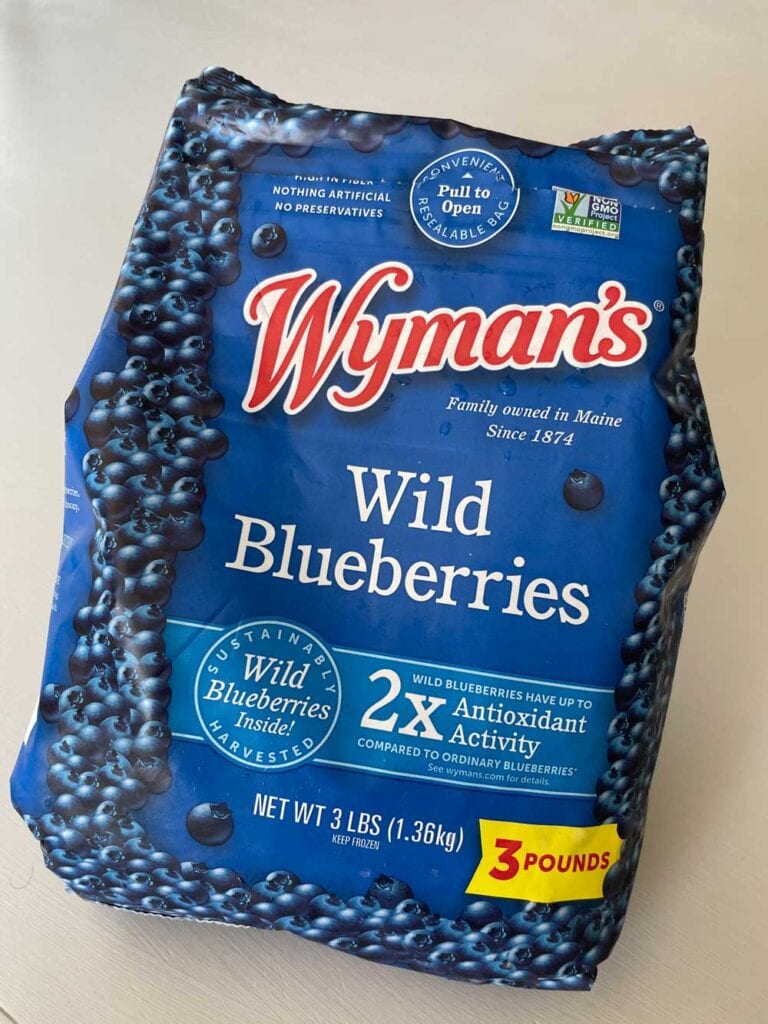
I have a preference for fresh produce for my family but it’s virtually impossible to grow blueberries in the Black Hills of South Dakota. When I concocted this blueberry jam from frozen blueberries years ago, I was SO PLEASANTLY SURPRISED at how good it turned out!
When you thaw your frozen blueberries for this jam, be sure to reserve the juice to use for the necessary liquid in this recipe.
What About Fresh Blueberries?
You can still use fresh blueberries if you prefer (or a combination of fresh & frozen). If you prefer to use fresh blueberries, you can still use my recipe. You may also want to use a combination of fresh & frozen berries that works perfectly well too.
Just be sure to use firm, ripe fruit. If you are busy harvesting and don’t have time to make your jam, it’s best to freeze your berries at their peak ripeness and make them into jam later.
Ingredients for Blueberry Jam
Making blueberry jam from frozen blueberries requires minimal ingredients. For a basic jam, you will need:
- Blueberries (fresh or frozen)
- Sugar
- Lemon juice
- Pectin
- Water
- Butter, optional
Optional ingredients for added flavor can include vanilla extract, cinnamon, or nutmeg.
Choosing The Right Pectin
Pectin comes from apples or citrus and it is a plant-based substance that helps in setting up the jam. Blueberries are naturally low in pectin, so I prefer to add powdered pectin. I also include lemon juice, which helps the pectin release. In case you missed my little disclaimer earlier, blueberry jam does not gel up like you see many other fruit jams and jellies. Even with pectin, the consistency is closer to a soft jelly or preserve.
The Sugar Factor
Sugar plays a crucial role in making jam. It sweetens your blueberries, helps in setting, and acts as a preservative.
Low Sugar – If you would like to reduce the sugar in your jam, I highly recommend Pomona’s Pectin.
Excess Sugar – If you incorporate too much sugar, not only will your jam be too sweet but it may also cause the jam to be gritty and crystallized. Note that not enough acid also may contribute to crystalized jam.
Natural Sweetener – You also may substitute natural sweeteners for granulated sugar. Just be mindful of the differences in sweetness between refined and natural sweeteners as it may not be a 1:1 substitution ratio.
Tools You Need
Making jam requires some basic kitchen tools like:
- A large heavy-bottomed pot
- An immersion (stick) blender or masher
- A ladle
- Canning jars with lids and bands
- Funnel
- Jar Grabber
If you’d like to read more about canning supplies, click here for my post about budget canning, including supplies and costs.
Making the Blueberry Jam
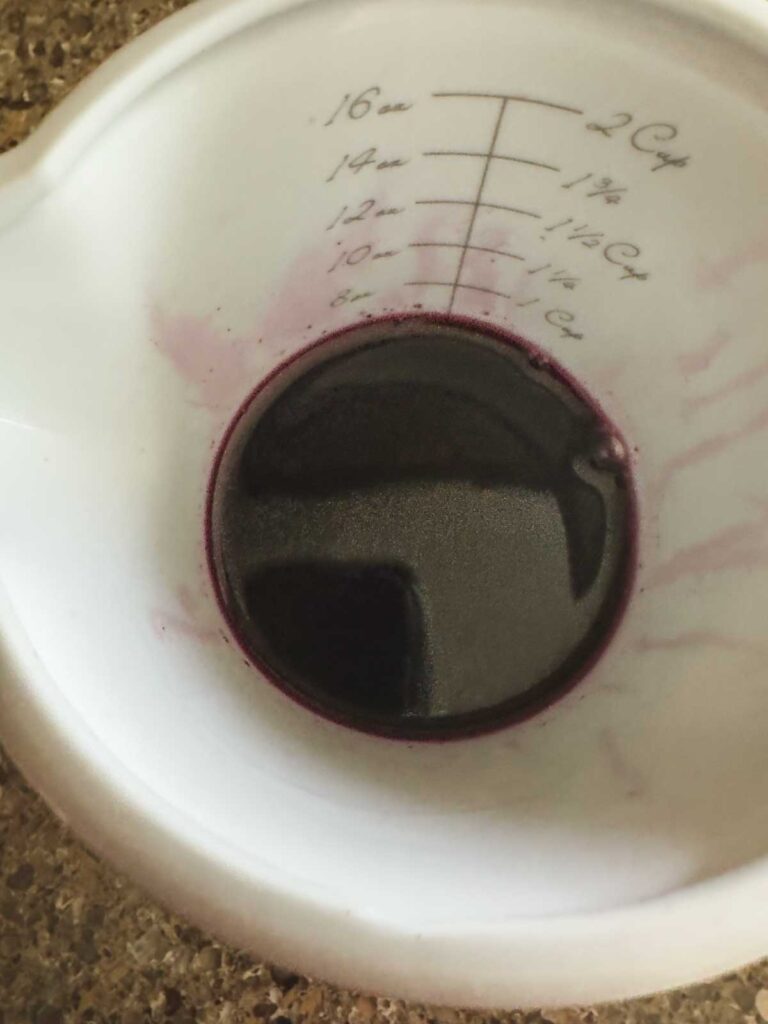
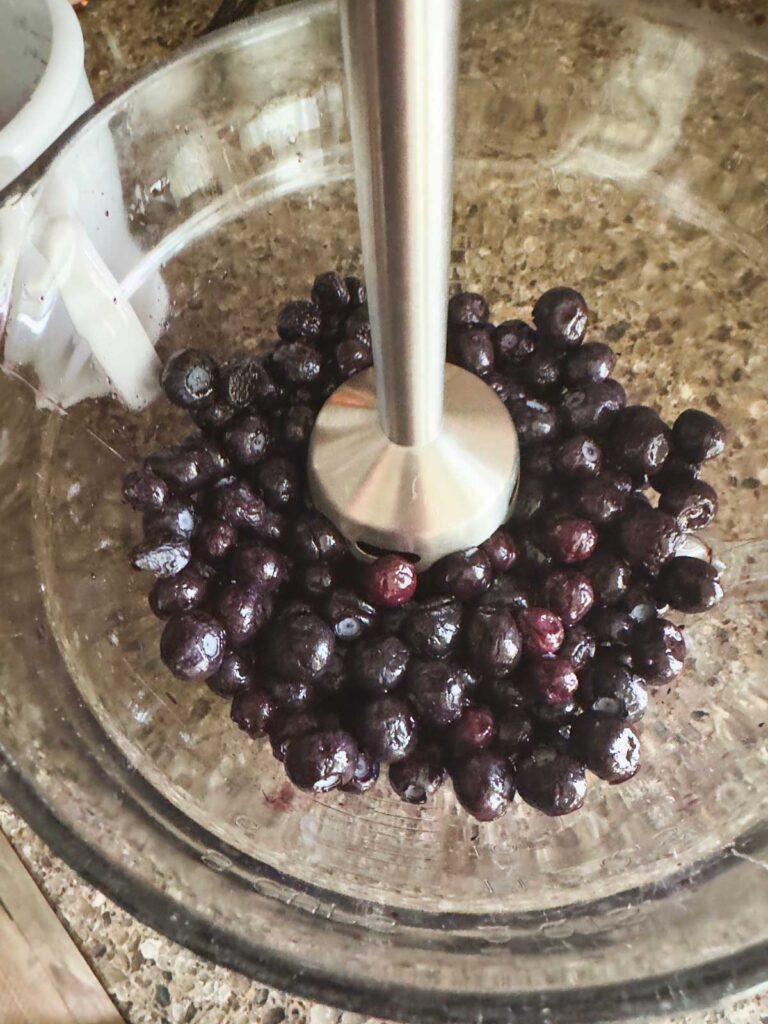
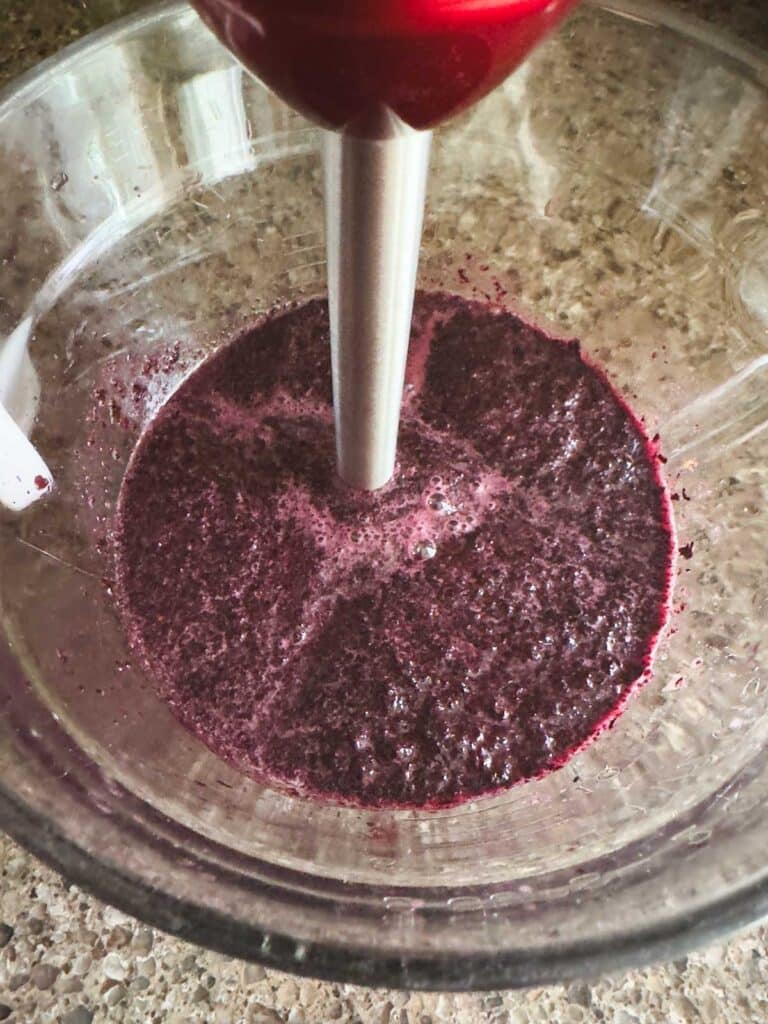
Making blueberry jam from frozen berries involves just a few simple steps:
- Start by thawing the frozen blueberries in a large pot.
- Drain and reserve any liquid from the thawed berries.
- Add enough water to the reserved blueberry juice (from thawing) to total ¾ cup of liquid.
- With an immersion(stick) blender or potato masher, crush the berries.
- Place your blueberries in a large pot
- To the blended or crushed berries, add the ¾ cup of liquid, lemon juice, and pectin.
- Bring the pot to a rolling boil over high heat. Stir the mixture constantly and add the sugar and optional butter to the mixture.
- Return the mixture to a full boil and boil for 1 minute constantly stirring.
- Remove the pot with your boiling jam from the heat and store or can according to your preference.
Checking the Blueberry Jam’s Consistency
When pectin is added to jam, you do not need to test your cooked jam’s consistency to determine whether it will set when cooled. Many people recommend doing a temperature test, spoon test, or plate test to confirm constancy regardless if there is added pectin or not. I also recommended testing consistency until recently. There is nothing wrong with testing pectin jam of course. Just be aware that the USDA says testing consistency is not necessary for pectin jam.
Storing Your Finished Jam
Once the jam is ready, transfer it into clean & sterilized jars and let it cool down. Once at room temperature, seal the jars and store them in the refrigerator. Homemade blueberry jam can last up to a month in the refrigerator. You can also freeze the jam for up to 1 year.
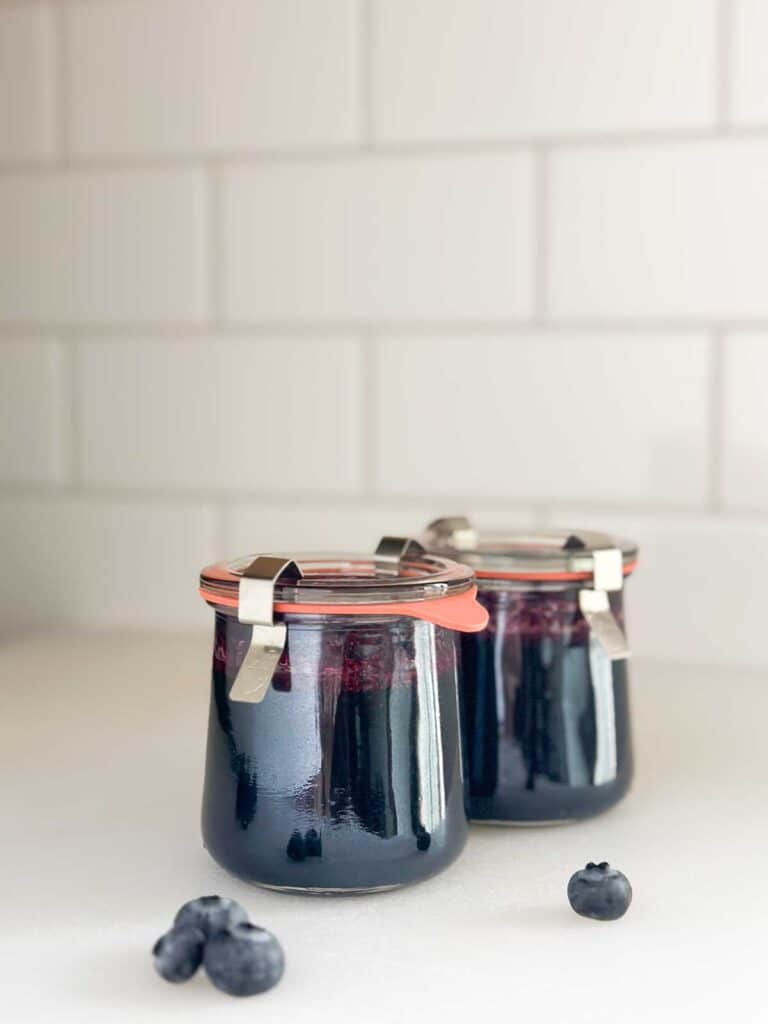
Canning the Blueberry Jam from Frozen Blueberries
If you want to preserve the jam for longer, you can process it in a water bath canner. This method involves processing the filled jam jars in boiling water to kill any bacteria, yeasts, or molds that might be present, extending the shelf life of the jam to several years.
To can follow these simple steps:
- Fill your sterilized canning jars with hot jam, leaving ¼ inch of headspace.
- Wipe rims with a clean and wet paper towel. Place lids on cleaned jars and finger-tighten rings.
- Process jam for 5 minutes in a water bath canner.
- Turn off the heat to your pot and let the jars remain covered for 5 minutes.
- With a jar grabber, carefully remove your canned jars from the canner and place them on a kitchen-towel-lined counter to cool completely for 8 to 10 hours.
- Once the jam is completely cooled, remove the rings and test lids to ensure they are sealed.
- To test: Carefully lift just the jar by grasping the lid of the jar. If the jar lifts with the lid, you have a good seal. If the lid separates from the jar, store your jam in the refrigerator or freezer.
- Wipe jars and lids clean with soapy water and store your jam in a cool place until you’re ready to enjoy your blueberry jam.
- Any jars that did not seal properly should be stored in the refrigerator or freezer.
Ways to Enjoy Your Blueberry Jam
Now that your homemade blueberry jam from frozen blueberries is ready, there are numerous ways to enjoy it. Spread it on toast, muffins, or biscuits. Stir it into yogurt, oatmeal, or smoothies. Use it as a filling for cheese Danish, cheesecake, or thumbprint cookies. Or simply spoon it over ice cream for a quick and delicious dessert.
Conclusion on Making Blueberry Jam from Frozen Blueberries
Making homemade blueberry jam from frozen berries is a rewarding experience that can be enjoyed year-round. Hopefully, you see that it is a simple process well worth the work. So, the next time you spot a bag of frozen blueberries, remember to whip up a batch of homemade blueberry jam from frozen blueberries.

Blueberry Jam from Frozen Blueberries
Description
Ingredients
- 5 cups blueberries, thawed & juice reserved
- 1 tbsp. lemon juice, bottled
- 5 ½ cups granulated sugar
- * ¾ cup water, (enough water added to reserved juice to equal ¾ cup of liquid)
- 1 tsp. butter, optional
- 1 (1.75 oz) box powdered pectin
Optional Flavorings
- ½ tsp nutmeg or cinnamon
- 1 tsp vanilla extract
Instructions
- Start by thawing the frozen blueberries in a large bowl.
- Drain and reserve any liquid from the thawed berries.
- Add enough water to the reserved juice to equal 3/4 cup of liquid.
- With an immersion(stick)blender or potato masher, crush the berries until they are your preferred consistency. (I like mine blended smooth)
- Place your blueberries in a large pot.
- To the blended or crushed berries, add the ¾ cup of water/juice mixture, lemon juice, and pectin.
- Bring the pot to a boil over high heat. Str the mixture constantly and add the sugar and optional butter.
- Return the mixture to a full boil and boil for 1 minute constantly stirring.
- Remove the pot with the boiling jam from the heat immediately and skim any foam off the top.
- Store you jam according to your preferences.
To Waterbath Can
- Pour the hot jam into sterilized and hot jars, leaving ¼ inch of headspace.
- Wipe the rim with damp cloth and place lids on top of the jars.
- Screw bands over lids to fingertip tight.
- Place jars in a water bath canner with the water level at least 1 inch over the jars.
- Bring the water to a boil and process for 5 minutes.
- Turn off the heat and leave the jars in the canner for 5 minutes before removing the jars from the canner with a jar grabber.
- Do not disturb the jars for 8 to 10 hours.
- Once the jam is completely cooled, remove the rings and test lids to ensure they are sealed.
- To test: Carefully lift just the jar by grasping the lid of the jar. If the jar lifts with the lid, you have a good seal. If the lid separates from the jar, store your jam in the refrigerator or freezer.
- Wipe jars and lids clean with soapy water and store your jam in a cool place until you’re ready to enjoy your blueberry jam.
- Any jars that did not seal properly should be stored in the refrigerator or freezer.
Recipe Notes
Nutrition
As an Amazon Associate, I earn from qualifying purchases at no extra cost to you. Thank you for your support!

Can I place your jam on a shelf in my pantry. I don’t have room in my freezer for anything else
Hi Merle,
Yes, this blueberry jam is shelf-stable and can remain in the pantry until you open it to enjoy.
Happy Canning!
How many jars are needed for recipe ?? Article does not say…
Hi there! The recipe makes a total of four half-pint jars.
I tried this recipe and we love it!
I used 9 jam jars (260ml)
Can I double this recipe
Hi Mary, I do not recommend you double the recipe.
can I try to water bath my jars again if they don’t deal the 1st time?
Yes, you sure can! I’ve done that before and it works well!!